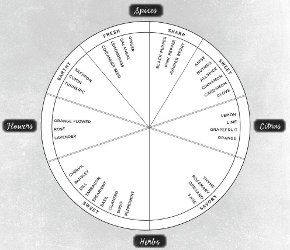
The Art of Flavor: Practices and Principles for Creating Delicious Food might be as easily shelved with the biography of Winston Churchill in your living room as it is in the kitchen with the cookbooks. The Art of Flavor’s style is more that of a friendly textbook than a compilation of recipes. Don’t come to it for glossy photos of what you hope will be the main course of your next dinner party. Read it for an understanding of how to create the main course yourself.
Mandy Aftel and Daniel Patterson wrote The Art of Flavor. Perfume aficionados already know Aftel as a natural perfumer, author, and founder of Aftelier. A quick glance at the Aftelier website shows Aftel’s interest in food — she sells oils to add to food, and scented teas. Daniel Patterson is the Michelin two-star chef who founded Coi and Alta, among other restaurants. He was also named Food and Wine’s Best New Chef and won the James Beard Award for Best Chef in the West. Before writing The Art of Flavor, Aftel and Patterson had collaborated on a previous cookbook, Aroma: The Magic of Essential Oils in Food and Fragrance.
Maybe the best way to describe The Art of Flavor is spelled out at the end of the first chapter: “…the recipe industry has flourished, with hundreds of versions of any dish available at the touch of a keyboard. But while many of these recipes describe beautiful and delicious dishes, somehow the art of flavor — the understanding that governs which foods go best together, and how — remains under-explored terrain. That is where we are going in this book, and we want to take you with us.”
After the introduction, The Art of Flavor presents a series of lessons. For instance, chapter four examines the “four rules of flavor.” Rule one is “similar ingredients need a contrasting flavor.” The chapter acknowledges that similar flavors — macaroni and cheese, for instance — provide comfort, but can ultimately become boring. (That’s why a dash of cayenne or dollop of mustard can make mac and cheese so much more satisfying.) The chapter then introduces a recipe for potato-leek salad with radicchio and olive-anchovy vinaigrette to encourage us to explore contrasts. Peppering the chapters are quotes from old texts on perfume and food that illuminate the lessons and give historical context.

As you might expect, the rules multiply and build upon each other. For example, food has top, middle and base notes, just like perfume. Also, the book introduces a “flavor compass” that examines flavor through flowers, spices, citrus, and herbs. This is broken down even further, as spices can be earthy, sharp, fresh, sweet, and savory. Add to that cooking methods and concepts of “locking” and “burying” flavors, and a final dish’s impact can feel like the result of an Einstein-stumping equation.
In other words, The Art of Flavor isn’t a passive read. If you want a cookbook to drool over while you flip its full-color pages in bed, this book won’t make the list. But, if you’re intrigued by what makes a dish something that both surprises and satisfies, and you enjoy playing with ingredients, The Art of Flavor will give you an understanding of composing a dish that will boost your skills far beyond what the latest TV celebrity chef would do. At 276 pages, The Art of Flavor isn’t gigantic, but every page demands attention to make the most of its lessons. Once you’ve graduated from its pages, dinner should be a lot more interesting.
The Art of Flavor: Practices and Principles for Creating Delicious Food (Riverhead Books, 2017) by Mandy Aftel and Daniel Patterson is $28.
Sounds really interesting. I allways thought food and perfume were similar. I’m not a great cook, but I think I’m pretty good with flavours. I have never used essential oils in cooking, if you don’t count lavender biscotti. But I do sprinkle a tiny but of ethyl maltol whenever I use vanilla in baking, though. It would probably work well with maple syrup, too. Hmm…
I think frankincense would be good in baked goods, too, with the vanilla. I’m envisioning a Wise Man Cake in time for the holidays, now!
Reading the title alone, I know I NEED this book 😉 I studied Food Technology (Not just your basic home-ec but also the science behind it!) and it was interesting to understand why certain ingredients complement each other and how the umami multiplies when the combinations are right.
One simple party food to serve in your year-end party: Bruschetta with soya sauce butter sauteed scallops. [Melt butter in pan and sauté your scallops until seasoning point. Instead of your usual salt and pepper, swirl in some soy sauce and smell the magic! – I recommend using fresh, big, meaty scallops and leave the centre a little rare] 🙂
The scallops sound fabulous! I’ll have to try them soon. I have a friend who puts a few drops of soy sauce in her salad dressing, and that’s pretty good, too.
This sounds cool, thanks so much for reviewing it, Angela!
You’re welcome!